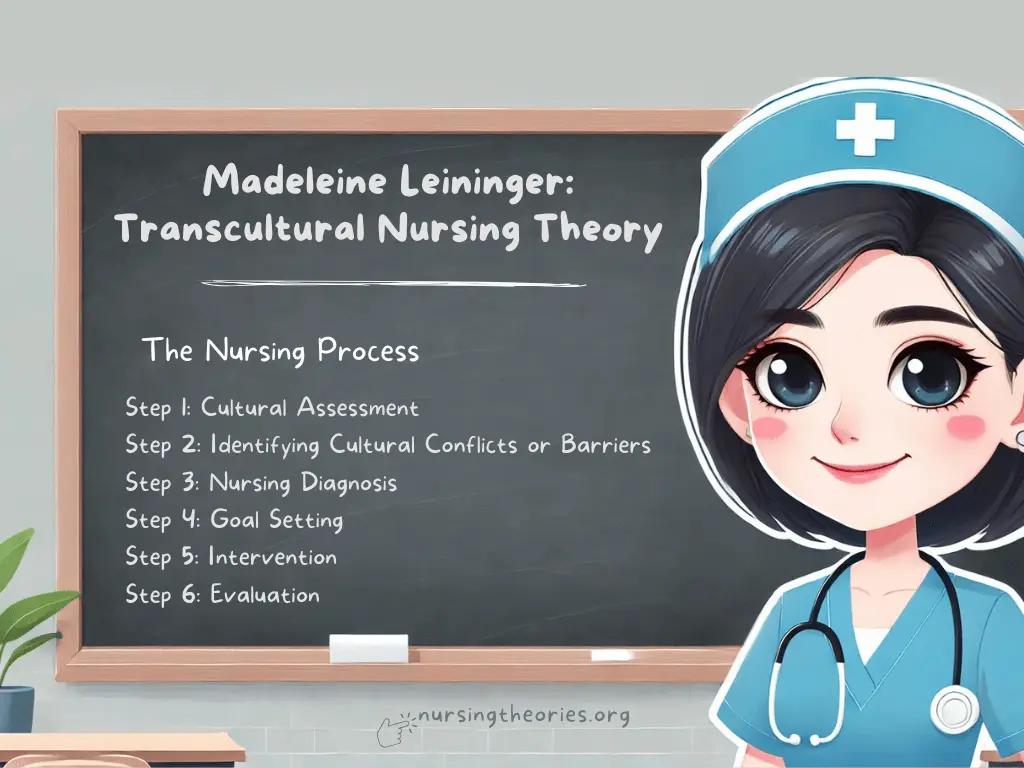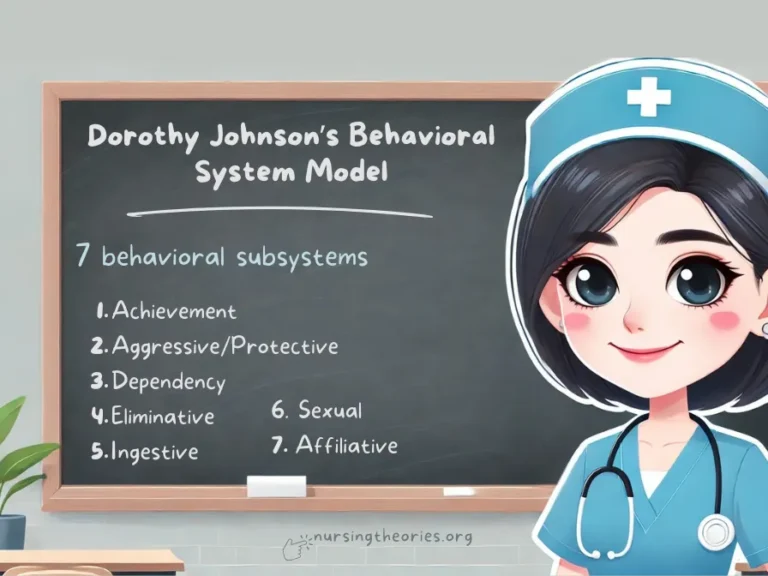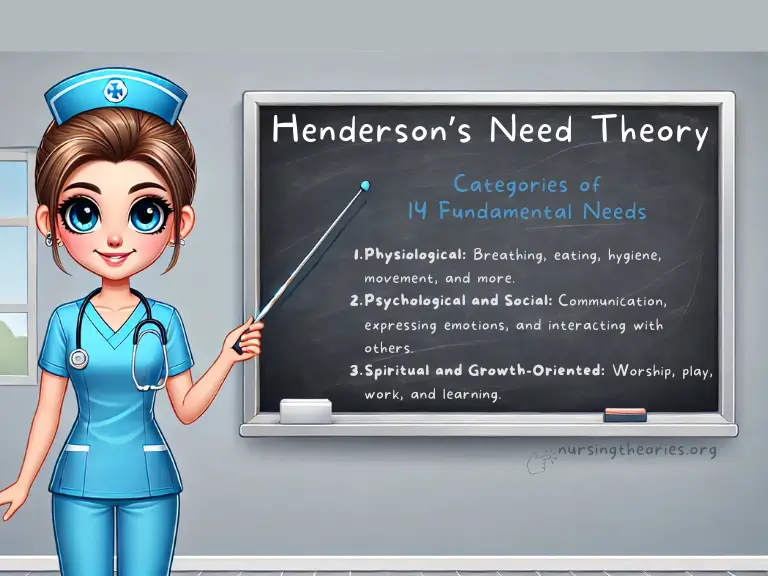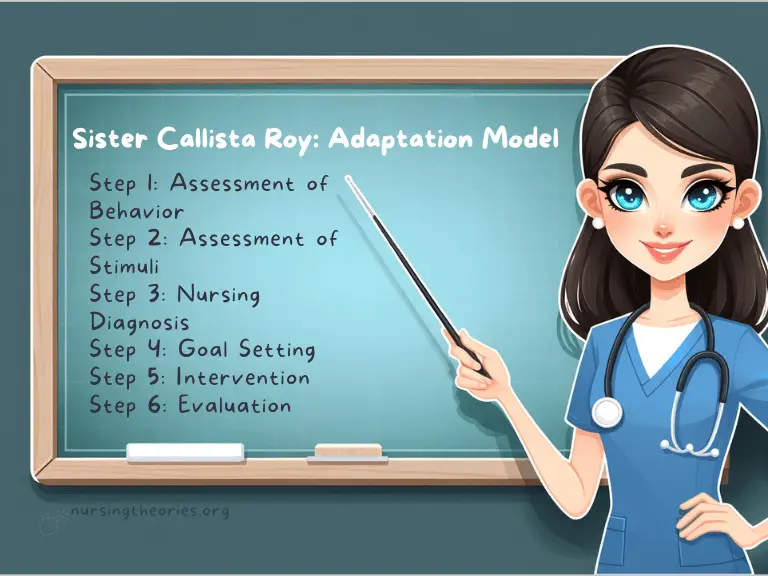Madeleine Leininger, a pioneer in the field of transcultural nursing, fundamentally transformed how nurses approach patient care by introducing the Transcultural Nursing Theory.
With an emphasis on delivering culturally congruent care, this theory highlights the importance of understanding and respecting a patient’s cultural background, beliefs, and values to achieve better health outcomes.
As the first nursing theorist to formally address the impact of culture on healthcare, Leininger developed the Sunrise Model, a framework that guides nurses in assessing and incorporating cultural factors into patient care.
In a world where healthcare systems serve increasingly diverse populations, her contributions are more relevant than ever.
In this article, we’ll explore the core concepts of transcultural nursing, break down its practical applications through real-world case studies, and examine how it remains essential in modern nursing practice.

What You’ve Learned – Madeleine Leininger’s Transcultural Nursing Theory
- Cultural care is central to effective nursing: Understanding and integrating a patient’s cultural beliefs, values, and practices promote more effective care and improved health outcomes.
- The three modes of nursing actions: Nurses can provide culturally congruent care through cultural preservation, accommodation, or repatterning.
- The Sunrise Model guides assessments: The model identifies key cultural influences on healthcare decisions, such as religion, family, and social factors, helping nurses develop tailored care plans.
- Transcultural nursing reduces health disparities: By addressing cultural needs, nurses can bridge gaps in health access, education, and outcomes for diverse populations.
- Cultural competence is a dynamic process: Nurses must continually learn, reflect, and adapt to the cultural contexts of their patients to provide individualized and respectful care.
Core Concepts of Transcultural Nursing Theory
Cultural Care as the Foundation
At the heart of Leininger’s theory is the concept of cultural care, which emphasizes the need to provide care that fits the patient’s cultural values and beliefs.
Recognizing that patients come from diverse backgrounds with unique traditions and customs, Leininger argued that understanding these aspects is essential for effective nursing practice.
Why It Matters:
When nurses fail to consider cultural beliefs, patients may experience discomfort, non-compliance, or mistrust, which can hinder recovery.
Example:
A nurse caring for a Muslim patient during Ramadan must understand the significance of fasting and work to create a care plan that accommodates the patient’s dietary needs without compromising their health.
Key Insight:
Cultural care ensures that nursing interventions respect the patient’s background while promoting healing and well-being.
Think of it as…
Listening to the rhythm of a song to play along harmoniously rather than disrupting the melody.
The Three Modes of Nursing Decisions and Actions
Leininger outlined three primary ways that nurses can ensure culturally appropriate care:
- Cultural Preservation or Maintenance:
- Supporting and preserving beneficial cultural practices.
- Example: Encouraging a patient from a Native American background to continue traditional herbal remedies, as long as they don’t conflict with prescribed treatments.
- Cultural Accommodation or Negotiation:
- Helping patients modify or negotiate cultural practices when necessary.
- Example: Assisting a Jehovah’s Witness patient in finding alternatives to blood transfusions in line with their religious beliefs.
- Cultural Repatterning or Restructuring:
- Modifying harmful or ineffective cultural practices to improve health outcomes.
- Example: Educating a diabetic patient from a culture with high sugar consumption on how to adapt traditional recipes to healthier versions.
Key Insight:
Each mode provides a tailored approach to balancing cultural respect and optimal care.
Think of it as…
A chef modifying a traditional recipe without losing its authentic flavor to suit a guest’s dietary restrictions.
Sunrise Model: Understanding Cultural Influences
Leininger’s Sunrise Model is a visual framework that illustrates the various factors influencing a patient’s healthcare decisions.
These factors include:
- Cultural values and lifestyle
- Religious beliefs
- Kinship and social structures
- Political and legal factors
- Educational background
- Technological resources
Why It’s Important:
Nurses can use the model to assess how each factor affects a patient’s ability to understand, accept, and adhere to medical advice.
Example:
When treating an elderly immigrant patient, understanding their reliance on family input for medical decisions is crucial in creating a successful treatment plan.
Key Insight:
The Sunrise Model highlights that healthcare outcomes are not solely dependent on physical interventions but are shaped by various socio-cultural factors.
Think of it as…
Viewing patient care through a kaleidoscope, where multiple elements combine to form the bigger picture.
The Nursing Process in Transcultural Nursing
Leininger’s Transcultural Nursing Theory integrates seamlessly with the nursing process, offering a step-by-step approach to provide culturally sensitive and individualized care.
This process ensures that cultural considerations are embedded into patient assessment, planning, intervention, and evaluation.
Step 1: Cultural Assessment
The first step involves gathering information about the patient’s cultural background, beliefs, values, and health practices.
This assessment aims to identify potential areas of conflict or alignment between the patient’s cultural needs and the care plan.
Key Questions to Ask:
- What cultural practices influence the patient’s view of health, illness, and treatment?
- Are there any religious or traditional beliefs that need to be considered during care?
- Who makes health-related decisions in the patient’s family or community?
Example:
For a Hispanic patient, a nurse may learn through assessment that family involvement is vital in decision-making.
Understanding this dynamic allows the nurse to involve family members in the care plan, promoting better outcomes.
Key Insight:
A thorough cultural assessment is foundational for designing care that respects the patient’s preferences while meeting clinical goals.
Think of it as…
Mapping out a road trip by gathering important details about the terrain and potential obstacles along the way.
Step 2: Identifying Cultural Conflicts or Barriers
Once the assessment is complete, the next step is to identify any conflicts between the patient’s cultural practices and the recommended medical interventions.
Potential Barriers to Consider:
- Language differences that may lead to misunderstandings
- Religious restrictions that may conflict with medical advice
- Cultural stigmas related to certain illnesses or treatments
Example:
A nurse working with a Buddhist patient undergoing chemotherapy may discover that the patient prefers herbal remedies to manage symptoms.
The nurse must balance the patient’s preference with evidence-based treatment to avoid adverse outcomes.
Key Insight:
By addressing conflicts early, nurses can avoid patient non-compliance and create more effective care plans.
Think of it as…
Spotting and resolving detours on a planned route to ensure a smoother journey.
Step 3: Nursing Diagnosis
Using data from the assessment and analysis of cultural conflicts, nurses develop a culturally appropriate nursing diagnosis.
Example Diagnosis:
- Risk of ineffective health maintenance related to religious dietary restrictions that limit adherence to prescribed nutrition plans.
Key Insight:
Nursing diagnoses must reflect both the patient’s cultural values and their medical needs to develop targeted interventions.
Think of it as…
Identifying the root cause of a plant’s poor growth by considering environmental factors, soil conditions, and watering habits.
Step 4: Goal Setting
Mutual goal-setting ensures that both the nurse and the patient agree on achievable outcomes that respect the patient’s cultural beliefs.
Example Goals:
- The patient will demonstrate knowledge of alternative low-sodium foods that fit within cultural dietary traditions within three days.
- The patient will verbalize comfort with the negotiated care plan after a discussion with the nurse and family members.
Key Insight:
Clear and collaborative goals promote cooperation, enhancing the patient’s willingness to engage in their care.
Think of it as…
Setting milestones on a journey where both the traveler and guide agree on the destination and the best path to get there.
Step 5: Intervention
Nurses implement interventions that address cultural needs while promoting health and wellness.
This may involve education, negotiation, and collaboration with the patient and their family.
Example Interventions:
- Providing translated educational materials or interpreters for non-English-speaking patients.
- Offering culturally appropriate dietary alternatives for patients with dietary restrictions.
- Engaging religious or spiritual leaders to provide comfort and guidance when needed.
Key Insight:
Tailored interventions ensure that patients feel understood, respected, and supported throughout their care journey.
Think of it as…
Adjusting the sails of a boat to work with the wind rather than against it.
Step 6: Evaluation
Finally, nurses evaluate the effectiveness of the interventions and whether the set goals were achieved.
If necessary, adjustments are made to the care plan to better meet the patient’s needs.
Evaluation Criteria:
- Did the patient demonstrate improved adherence to the care plan?
- Were any cultural barriers successfully addressed or minimized?
- Is the patient satisfied with the care provided and the level of cultural respect shown?
Example:
After providing culturally tailored diabetic education, a nurse evaluates whether the patient is making healthier food choices that align with both their culture and their medical needs.
Key Insight:
Continuous evaluation allows for flexible care, ensuring that changes in the patient’s condition or beliefs are addressed promptly.
Think of it as…
Checking the map periodically during a road trip to ensure the destination is on track and no adjustments are needed.
Real-World Applications of Transcultural Nursing Theory
Leininger’s Transcultural Nursing Theory is highly practical and applicable in various healthcare settings, including acute care, chronic disease management, and community health programs.
The following case studies demonstrate how culturally congruent care can lead to better patient outcomes.
Case Study 1: Managing Diabetes in a Muslim Patient During Ramadan
Scenario:
A 50-year-old Muslim man with type 2 diabetes wishes to fast during Ramadan but is concerned about how fasting may affect his blood sugar levels.
Application of Transcultural Nursing Theory:
- Cultural Preservation: The nurse acknowledges and supports the patient’s desire to observe Ramadan while ensuring it is done safely.
- Cultural Accommodation: The nurse works with the patient to modify meal times, medication schedules, and glucose monitoring to fit the fasting period.
- Cultural Repatterning: The nurse educates the patient on how to choose foods that stabilize blood sugar during pre-dawn and post-sunset meals.
Outcome:
The patient successfully completes the month of fasting without severe glucose fluctuations, demonstrating that culturally congruent care can enhance adherence and satisfaction.
Key Insight:
Respecting religious practices while promoting safe health outcomes builds trust between patients and healthcare providers.
Think of it as…
Merging two paths into one—ensuring that cultural values and medical advice work in harmony.
Case Study 2: End-of-Life Care for a Hindu Family
Scenario:
A 70-year-old Hindu man with terminal cancer is receiving palliative care.
His family is deeply involved in his care and requests the incorporation of religious rituals during his final days.
Application of Transcultural Nursing Theory:
- Cultural Preservation: The nurse supports the family’s request to perform prayers and rituals in the patient’s room.
- Cultural Accommodation: The nurse ensures that hospital policies are followed while allowing flexibility for the family’s needs.
- Cultural Repatterning: The nurse provides information on pain management, helping the family understand that medication will not interfere with the patient’s spiritual transition.
Outcome:
The family expresses gratitude for the culturally respectful care, and the patient experiences a peaceful transition with minimal discomfort.
Key Insight:
End-of-life care that respects spiritual needs can offer emotional comfort and dignity to both patients and their families.
Think of it as…
Creating a calm, sacred space where healing extends beyond the physical and into the emotional and spiritual realms.
Case Study 3: Maternal Care for an Immigrant Woman
Scenario:
A pregnant woman from a rural African community, now living in an urban area, is hesitant to attend prenatal checkups due to unfamiliar healthcare practices.
Application of Transcultural Nursing Theory:
- Cultural Preservation: The nurse supports any traditional birth practices that do not pose risks.
- Cultural Accommodation: The nurse provides educational materials in the patient’s native language and offers flexible appointment times to ease her concerns.
- Cultural Repatterning: The nurse educates the patient on the importance of regular prenatal checkups while working with her to integrate traditional and modern practices.
Outcome:
The patient feels more comfortable attending appointments, leading to improved maternal and fetal health outcomes.
Key Insight:
Bridging traditional practices and modern medicine fosters better engagement and positive outcomes in maternal care.
Think of it as…
Crossing a bridge that connects two worlds, ensuring both are acknowledged and respected.
Modern Implications of Transcultural Nursing
In an increasingly multicultural world, Leininger’s Transcultural Nursing Theory remains vital in addressing health disparities, integrating cultural competence in nursing education, and adapting to technological advancements that influence patient care.
Addressing Health Disparities in Multicultural Communities
Healthcare disparities—such as differences in access, quality of care, and outcomes—are often linked to cultural and linguistic barriers.
By integrating cultural competence, nurses can bridge these gaps and promote equitable care.
Example:
A community health program targeting minority populations could employ bilingual nurses and culturally tailored outreach initiatives to increase participation in preventive care.
Key Insight:
When healthcare providers understand and respect cultural differences, patients are more likely to seek care, adhere to treatment, and experience better outcomes.
Think of it as…
Breaking down barriers to build bridges of trust and understanding between patients and healthcare providers.
Integrating Cultural Competence in Nursing Education
Nursing schools increasingly incorporate cultural competence training as part of the core curriculum.
By equipping future nurses with the skills to provide culturally sensitive care, the healthcare workforce becomes better prepared to meet the needs of diverse populations.
Application in Practice:
- Simulation-based learning where students encounter patients with different cultural needs.
- Reflection exercises to help students recognize and overcome personal biases.
- Multicultural internships or fieldwork experiences.
Key Insight:
Educating nurses early on ensures that cultural sensitivity is not an afterthought but an integral part of patient care.
Think of it as…
Planting seeds of understanding during training, which grow into culturally aware nursing practices.
Technology and Globalization’s Impact on Cultural Care
The rise of telehealth and global migration has made cultural competence even more essential.
Nurses may now care for patients from different cultural backgrounds, often without face-to-face interactions.
Example:
Telehealth platforms can incorporate interpreters and cultural liaisons to bridge language and cultural gaps during virtual consultations.
Key Insight:
Technology, when used effectively, can enhance culturally congruent care, but it also requires sensitivity to potential digital divides and access issues.
Think of it as…
Navigating an expanding global village where cultural awareness is the key to effective connections.
Challenges and Limitations of Transcultural Nursing
Despite its many benefits, implementing Leininger’s Transcultural Nursing Theory can be challenging in certain healthcare environments.
Recognizing and addressing these limitations is essential to providing effective, culturally congruent care.
Time Constraints in Conducting Cultural Assessments
Cultural assessments require time to gather detailed information about a patient’s background, values, and beliefs.
In fast-paced environments, such as emergency departments, this may be difficult to achieve.
Example:
An ER nurse treating a patient in acute pain may not have time to fully assess how cultural beliefs influence the patient’s perception of pain and treatment preferences.
Solution:
Develop quick cultural assessment tools that help nurses identify key cultural considerations without delaying urgent care.
Key Insight:
Even brief cultural insights can significantly impact patient outcomes and satisfaction when integrated into care.
Think of it as…
Taking a snapshot of key details when there’s no time for a full portrait.
Balancing Cultural Practices and Medical Protocols
Some cultural practices may conflict with evidence-based medical protocols, creating ethical dilemmas for healthcare providers.
Example:
A patient from a culture that prioritizes traditional healing methods may resist conventional treatment, such as chemotherapy.
Solution:
Nurses can educate patients about the benefits of combining traditional practices with medical treatments or offer alternative approaches where possible.
Key Insight:
Negotiation and education are vital to finding a middle ground between respecting cultural beliefs and ensuring patient safety.
Think of it as…
Walking a tightrope where balance ensures both cultural respect and positive health outcomes.
Overcoming Personal Biases
Healthcare providers may unknowingly harbor biases that affect their ability to provide culturally sensitive care.
Example:
A nurse may assume that a patient from a specific cultural background is non-compliant without fully understanding the cultural reasons behind their behavior.
Solution:
Ongoing training, self-reflection, and cultural competence workshops can help nurses identify and overcome biases.
Key Insight:
Self-awareness is the foundation for empathy and culturally appropriate care.
Think of it as…
Cleaning the lens of a camera to ensure a clear and unbiased view of the subject.
Transcultural Nursing Theory Quiz
- What is the primary goal of Leininger’s Transcultural Nursing Theory?
a) Eliminate cultural diversity in healthcare settings
b) Provide culturally congruent care that improves patient outcomes
c) Prioritize traditional medicine over Western medicine
d) Standardize nursing interventions globally
- Which of the following best describes cultural preservation in nursing?
a) Helping patients abandon cultural practices
b) Supporting and maintaining beneficial cultural traditions
c) Restructuring harmful cultural practices
d) Negotiating new cultural behaviors
- What is a key component of the Sunrise Model?
a) Medical history
b) Cultural, social, and religious factors
c) Genetic predisposition
d) Dietary restrictions only
- How can nurses address conflicts between medical protocols and cultural beliefs?
a) Ignore the patient’s preferences to follow strict guidelines
b) Educate and negotiate with the patient to find a balance
c) Dismiss medical protocols to accommodate all cultural practices
d) Refer the patient to another healthcare facility
- Why is self-awareness important for nurses providing transcultural care?
a) It helps them better understand their own biases and improve care
b) It reduces the need for cultural assessments
c) It allows nurses to impose their beliefs on patients
d) It eliminates the need for patient education
Transcultural Nursing Theory Quiz Answers with Rationale
- Correct Answer: b) Provide culturally congruent care that improves patient outcomes
Rationale: The primary goal of Leininger’s theory is to provide care that fits the patient’s cultural background, promoting effective health outcomes. - Correct Answer: b) Supporting and maintaining beneficial cultural traditions
Rationale: Cultural preservation focuses on upholding cultural practices that positively contribute to health. - Correct Answer: b) Cultural, social, and religious factors
Rationale: The Sunrise Model identifies various factors, including religion and family structure, that influence healthcare decisions. - Correct Answer: b) Educate and negotiate with the patient to find a balance
Rationale: Nurses should aim to strike a balance between cultural beliefs and evidence-based care through patient education and mutual agreement. - Correct Answer: a) It helps them better understand their own biases and improve care
Rationale: Self-awareness allows nurses to recognize and address biases that could negatively impact their ability to provide culturally appropriate care.
Questions and Answers of Transcultural Nursing
Q1: What is the purpose of cultural assessment in transcultural nursing?
A: To understand the patient’s cultural values, beliefs, and practices to tailor care accordingly.
Q2: How do cultural conflicts arise in nursing care?
A: Conflicts occur when a patient’s cultural practices contradict medical advice or hospital policies.
Q3: What role does the Sunrise Model play in nursing care?
A: It helps nurses identify and evaluate cultural factors that influence patient health and care decisions.
Q4: How can nurses support culturally diverse patients who speak limited English?
A: By using interpreters, providing translated materials, and offering visual aids to improve communication.
Q5: Why is cultural competence important in reducing health disparities?
A: It ensures that patients receive equitable, respectful care that meets their unique needs.
Conclusion
Madeleine Leininger’s Transcultural Nursing Theory revolutionized nursing by recognizing the profound impact of culture on health and well-being.
By integrating cultural assessments, preservation, accommodation, and repatterning into the nursing process, healthcare providers can deliver care that respects patients’ values while promoting optimal health outcomes.
In a world characterized by diverse populations and multicultural interactions, Leininger’s contributions remain essential in addressing health disparities and ensuring that every patient receives personalized, respectful, and effective care.
Final Reflective Question: How can you incorporate culturally sensitive practices into your daily nursing routine to foster trust and improve outcomes for patients from diverse backgrounds?




